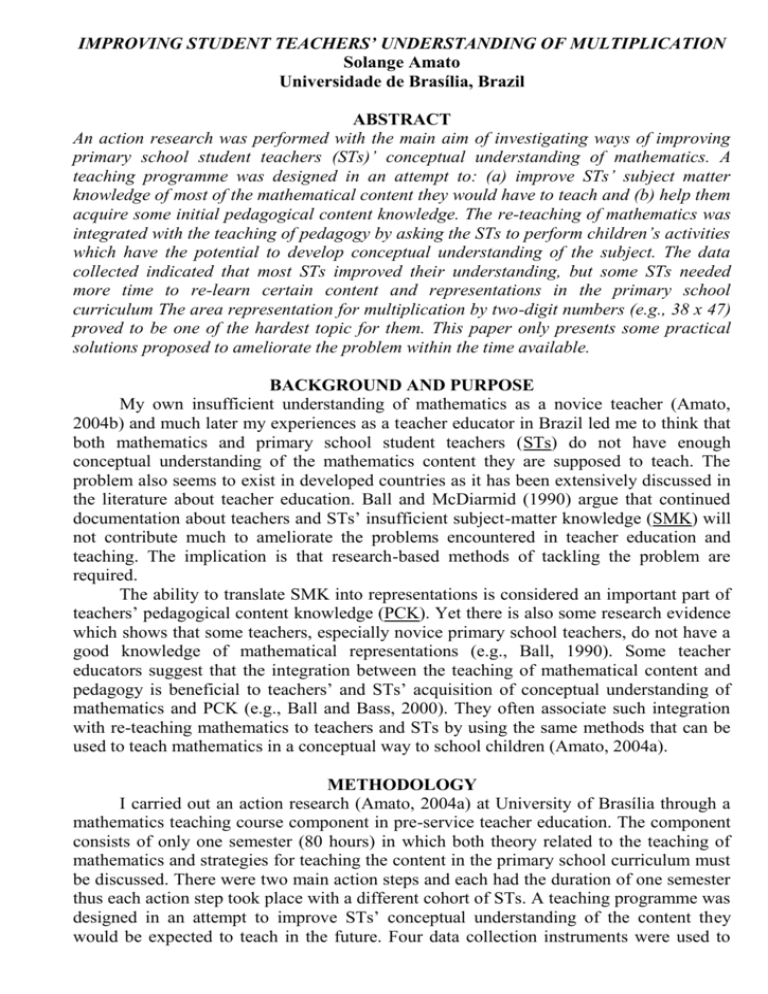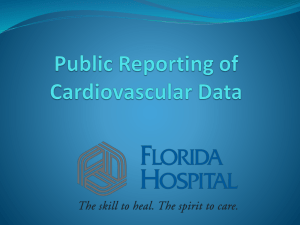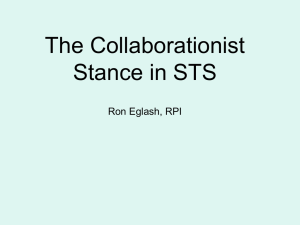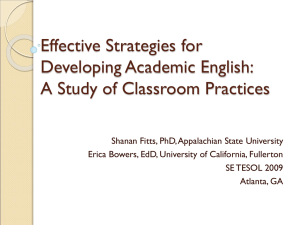Improving Student Teachers` Understanding Of Multiplication By
advertisement

IMPROVING STUDENT TEACHERS’ UNDERSTANDING OF MULTIPLICATION Solange Amato Universidade de Brasília, Brazil ABSTRACT An action research was performed with the main aim of investigating ways of improving primary school student teachers (STs)’ conceptual understanding of mathematics. A teaching programme was designed in an attempt to: (a) improve STs’ subject matter knowledge of most of the mathematical content they would have to teach and (b) help them acquire some initial pedagogical content knowledge. The re-teaching of mathematics was integrated with the teaching of pedagogy by asking the STs to perform children’s activities which have the potential to develop conceptual understanding of the subject. The data collected indicated that most STs improved their understanding, but some STs needed more time to re-learn certain content and representations in the primary school curriculum The area representation for multiplication by two-digit numbers (e.g., 38 x 47) proved to be one of the hardest topic for them. This paper only presents some practical solutions proposed to ameliorate the problem within the time available. BACKGROUND AND PURPOSE My own insufficient understanding of mathematics as a novice teacher (Amato, 2004b) and much later my experiences as a teacher educator in Brazil led me to think that both mathematics and primary school student teachers (STs) do not have enough conceptual understanding of the mathematics content they are supposed to teach. The problem also seems to exist in developed countries as it has been extensively discussed in the literature about teacher education. Ball and McDiarmid (1990) argue that continued documentation about teachers and STs’ insufficient subject-matter knowledge (SMK) will not contribute much to ameliorate the problems encountered in teacher education and teaching. The implication is that research-based methods of tackling the problem are required. The ability to translate SMK into representations is considered an important part of teachers’ pedagogical content knowledge (PCK). Yet there is also some research evidence which shows that some teachers, especially novice primary school teachers, do not have a good knowledge of mathematical representations (e.g., Ball, 1990). Some teacher educators suggest that the integration between the teaching of mathematical content and pedagogy is beneficial to teachers’ and STs’ acquisition of conceptual understanding of mathematics and PCK (e.g., Ball and Bass, 2000). They often associate such integration with re-teaching mathematics to teachers and STs by using the same methods that can be used to teach mathematics in a conceptual way to school children (Amato, 2004a). METHODOLOGY I carried out an action research (Amato, 2004a) at University of Brasília through a mathematics teaching course component in pre-service teacher education. The component consists of only one semester (80 hours) in which both theory related to the teaching of mathematics and strategies for teaching the content in the primary school curriculum must be discussed. There were two main action steps and each had the duration of one semester thus each action step took place with a different cohort of STs. A teaching programme was designed in an attempt to improve STs’ conceptual understanding of the content they would be expected to teach in the future. Four data collection instruments were used to monitor the effects of the strategic actions: (a) diary; (b) questionnaires; (c) interviews and (d) pre- and post-tests. Much information was produced by these instruments but, because of the limitations of space, only some STs’ responses concerning multiplication are reported in this paper. In the action steps of the research the re-teaching of mathematical content was integrated with the teaching of pedagogy by asking the STs to perform children’s activities which have the potential to develop conceptual understanding of the subject. Versatile representations (Amato, 2004a), like the area representation for multiplication, were often used in the activities in order to represent together two or more related concepts and operations and so to make their relationships clear. The STs in all action steps were first given some practice in using the area representation with concrete materials (a plane version of Dienes blocks, Figure 1) and later they were asked to interpret and draw area diagrams (Figure 2). 17 x 35 7 210 35 10 300 50 30 Figure 1 35 17x 245 350 595 5 Figure 2 SOME RESULTS A summary of the activities most often performed by the STs and more general results about the programme can be found in Amato (2004a). With respect to multiplication, Ball (1991) reports that although all STs could multiply large natural numbers, few of them used place value ideas to explain why the numbers move over in the partial products. Similar results were found in this study. In a pre-test question, the STs were asked to explain the reason for leaving blank the units’ place of the second addend in the multiplication algorithm for 45 x 123. The most frequent type of explanation was related to place value, but it did not involve much conceptual understanding: “Because I am now working with the tens’ place, then I write the next number under the tens”. Eight STs wrote about calculating 4 times 123 and none wrote about calculating 40 times 123. Two STs said that it was to make the result bigger. The ideas presented by a few STs were thought to have the potential to develop the belief that mathematics is an irrational subject: “I would say that the place is reserved for the + [addition] sign”. Using children’s activities proved to be an appropriate strategy to improve STs’ conceptual understanding of mathematics since the majority of STs in both semesters said in the questionnaires and interviews, and many indicated in the post-tests, that their understanding had improved. Having said that, it does not mean that there were not problems connected to the idea of using children’ methods with the STs. Some STs presented difficulties in re-learning most of the primary school curriculum in a single semester. The area representation for multiplication by two-digit numbers proved to be one of the hardest topics in the programme requiring much more attention than I had previously thought. The first action step The first semester STs took a long time to relate the area representation to the symbolic algorithm. One ST said that her difficulties were related to the way she had memorised the algorithm only by rote. She gave an example concerning 38 x 47: “I would do 8 x 7, 8 x 4, jump a place, 3 x 7 and 3 x 4. I did not interpret the three in the tens’ place as 30 times and the four as 4 tens or 40”. The STs had memorised symbolic ways of performing operations which seemed to be interfering with their learning of new and more conceptual representations for these operations (Hiebert and Carpenter, 1992 and Amato, 2004a). Decisions made: STs’ understanding of the area representation was thought to require explicit teaching of the conventions used in those representations. Still in the first semester, the STs were asked to start the representation using the bigger pieces from bottom to top and from left to right (Figures 1 and 2) because in this particular way multiplication by two-digit numbers is seen as an extension of the previous work on multiplication by a single digit. I also decided to increase the number of activities about multiplication by two-digit numbers in order to provide STs with some revisions with extensions and so a greater possibility of reconstructing the related ideas and of learning the appropriate conventions. The second action step A few second semester STs also had difficulty in learning the area representation. Similarly to the first semester STs, their rote way of thinking about the multiplication algorithm was thought to have caused some of these problems. In the post-test response when writing about the multiplication algorithm for 53 x 147 one ST wrote: “I would not let them [her future students] to get addicted to saying ‘5 times 7, 5 times 4, 5 times 1’. In truth, the 5 means 50 and 50 times 7 is 350, so this place is not blank but has a zero”. Some STs’ difficulties with the area representation were also thought to be the result of not having accessible some of the required pre-requisite knowledge about area. STs main recollections of the school work with area of rectangles were related only to the formula “b x h”. Decisions made: The number of activities related to the area representation for smaller multiplication sums (e.g., 3 x 8 and 5 x 42) was further increased in the third and subsequent semesters. These activities were started earlier in the semester in order to help STs develop the pre-requisite knowledge to extend the representation to larger sums. In order to help STs’ understand the conventions used in the area representation, an analogy was made with constructing a wall with big bricks (hundreds), medium bricks (tens) and small bricks (units). The STs were asked which they thought it would be quicker to construct a wall: (a) to use as many bigger bricks as possible or (b) to start the construction by using small bricks? Before using the “bricks” to construct the wall they were asked to use the strips (tens) and little squares (units) as “rulers” to measure the base and height of the wall (Figure 3). After they finished constructing the wall they were asked to remove the rulers and verbalise the four partial multiplication sums (7x5, 7x30, 10x5 and 10x30). 17 35 Figure 3 SOME CONCLUSIONS Hiebert and Carpenter (1992) suggest that after achieving automaticity learners become more reluctant to connect their well practised procedures to other mathematical representations that could provide further links to conceptual knowledge. On the other hand, primary school teachers have the social responsibility of helping children learn mathematics. They must develop the ability to work backwards from their symbolic ways of representing mathematics to more informal ways of representing the subject (Ball and Bass, 2000). So it was necessary to help STs draw out clear connections between the symbolic ways of representing mathematics they had in their minds before starting the course and other ways of representing the subject so that different representations for the same concept or operation could be incorporated in the same schema. The area representation can help school students to understand the conventional algorithm for multiplication. It can also help them to make connections between arithmetic and algebra and to understand that x2+y2 is different from (x+y)2 (Ball and Bass, 2004). Therefore, it was more appropriate to look for ways of helping the STs to be fluent in using the area representation than excluding it from the programme. Narrowing or avoiding the teaching of contents and representations which proved to be more difficult for my STs could certainly make my classroom life easier. Yet learning mathematics from teaching seems to be a slow process for primary school teachers, as they have to teach several subjects simultaneously (Amato, 2004b). When teachers find the time to work together in study groups they should be discussing complex problems related to their practice and not dedicate their precious time trying to acquire knowledge of contents and representations for the mathematics they teach. An initial knowledge base which I think it is a combination of a strong conceptual understanding of mathematics (SMK) and knowledge of a repertoire of representations (PCK) must be available to STs in pre-service teacher education. Otherwise their first students may well be led to think that mathematics is a complicated and unreachable form of knowledge because their teachers have not yet learned ways of communicating the subject. REFERENCES Amato, S. A. (2004a). Improving Student Teachers’ Mathematical Knowledge, Proceedings of the 10th International Congress on Mathematical Education, Copenhagen, Denmark, available at http://www.icme-organisers.dk/taA/. Amato, S. A. (2004b). Primary School Teachers’ Perceptions about their Needs Concerning Mathematics Teacher Education, Proceedings of the 10th International Congress on Mathematical Education, Copenhagen, Denmark, available at http://www.icme-organisers.dk/dg06/. Ball, D. (1990). The Mathematical Understanding that Prospective Teachers Bring to Teacher Education. Elementary School Journal, 90 (4): 449-466. Ball, D. (1991). Research on Teaching Mathematics: Making Subject Matter Knowledge Part of the Equation, in J. Brophy (ed.), Advances in Research on Teaching: Teachers’ Subject Matter Knowledge and Classroom Instruction, 2: 1-48, Greenwich, CT: JAI Press. Ball, D., & Bass, H. (2000). Interweaving Content and Pedagogy in Teaching and Learning to Teach: Knowing and Using Mathematics. In J. Boaler (ed.), Multiple Perspectives on Mathematics Teaching and Learning, Westport, CT: Ablex. Ball, D., & Bass, H. (2004). Knowing Mathematics for Teaching, in R. Strasser, G. Brandell, B. Grevholm and O. Helenius, Educating for the Future, Proceedings of an International Symposium on Mathematics Teacher Education, Sweden: The Royal Swedish Academy of Sciences. Ball, D. & McDiarmid, G. W. (1990). The Subject-Matter Preparation of Teachers, in W. R. Houston (ed.), Handbook of Research on Teacher Education, New York: Macmillan. Hiebert, J. & Carpenter, T. P. (1992). Learning and Teaching with Understanding, in D. Grouws (ed.), Handbook of Research on Mathematics Teaching and Learning, a Project of the National Council of Teachers of Mathematics (NCTM), New York: Macmillan.







